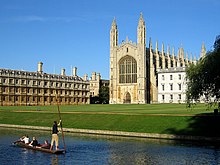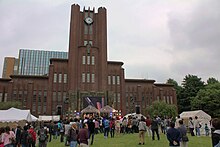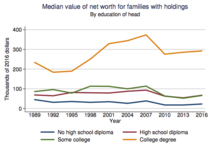| Revision as of 08:48, 2 February 2014 editQuest for Truth (talk | contribs)Extended confirmed users6,599 edits Higher education is part of tertiary education← Previous edit | Revision as of 22:13, 2 February 2014 edit undoVanishedUser sdu9aya9fs785 (talk | contribs)982 edits Undid revision 593555758 by Quest for Truth (talk) Higher education IS tertiary education.Next edit → | ||
| Line 1: | Line 1: | ||
| {{Distinguish|Tertiary education}} | |||
| ] is an ] institution of higher learning in ], ].]] | ] is an ] institution of higher learning in ], ].]] | ||
| ] is an institution of higher learning in ], ], ].]] | ] is an institution of higher learning in ], ], ].]] | ||
| ] is an institution of higher learning in the ].]] | ] is an institution of higher learning in the ].]] | ||
| ] is an institution of higher learning in ].]] | ] is an institution of higher learning in ].]] | ||
| ] is an institution of higher learning in ].]] | ] is an institution of higher learning in ].]] | ||
| ] is an institution of higher learning in ].]] | ] is an institution of higher learning in ].]] | ||
| ] is an institution of higher learning in ].]] | ] is an institution of higher learning in ].]] | ||
| ] is an institution of higher learning in ].]] | ] is an institution of higher learning in ].]] | ||
| '''Higher education''' is an optional final stage of ] that occurs after ]. Often delivered at ], ], ]s, ], and ], higher education is also available through certain college-level institutions, including ]s, trade schools, and other career colleges that award ]s or ]s. | '''Higher education''', '''post-secondary education''', '''tertiary education''' or '''third level education''' is an optional final stage of ] that occurs after ]. Often delivered at ], ], ]s, ], and ], higher education is also available through certain college-level institutions, including ]s, trade schools, and other career colleges that award ]s or ]s. | ||
| The right of access to higher education is mentioned in a number of ]. The ] ] of 1966 declares, in Article 13, that "higher education shall be made equally accessible to all, on the basis of capacity, by every appropriate means, and in particular by the progressive introduction of free education". In ], Article 2 of the ], adopted in 1950, obliges all signatory parties to guarantee the ]. | The right of access to higher education is mentioned in a number of ]. The ] ] of 1966 declares, in Article 13, that "higher education shall be made equally accessible to all, on the basis of capacity, by every appropriate means, and in particular by the progressive introduction of free education". In ], Article 2 of the ], adopted in 1950, obliges all signatory parties to guarantee the ]. | ||
Revision as of 22:13, 2 February 2014








Higher education, post-secondary education, tertiary education or third level education is an optional final stage of formal learning that occurs after secondary education. Often delivered at universities, academies, colleges, seminaries, and institutes of technology, higher education is also available through certain college-level institutions, including vocational schools, trade schools, and other career colleges that award academic degrees or professional certifications.
The right of access to higher education is mentioned in a number of international human rights instruments. The UN International Covenant on Economic, Social and Cultural Rights of 1966 declares, in Article 13, that "higher education shall be made equally accessible to all, on the basis of capacity, by every appropriate means, and in particular by the progressive introduction of free education". In Europe, Article 2 of the First Protocol to the European Convention on Human Rights, adopted in 1950, obliges all signatory parties to guarantee the right to education.
Overview
| This section does not cite any sources. Please help improve this section by adding citations to reliable sources. Unsourced material may be challenged and removed. (June 2013) (Learn how and when to remove this message) |
Higher education is an educational level that follows a completion of a school providing a secondary education, such as a high school, secondary school, or gymnasium. Tertiary education is normally taken to include undergraduate and postgraduate education, as well as vocational education and training. Colleges, universities, and institutes of technology are the main institutions that provide tertiary education (sometimes known collectively as tertiary institutions). Examples of institutions that provide post-secondary education are vocational schools, community colleges, independent colleges (e.g. institutes of technology), and universities in the United States, the institutes of technical and further education in Australia, pre-university colleges in Quebec, and the IEKs in Greece. They are sometimes known collectively as tertiary institutions. Completion of a tertiary education program of study generally results in the awarding of certificates, diplomas, or academic degrees.
Higher education includes teaching, research, exacting applied work (e.g. in medical schools and dental schools), and social services activities of universities. Within the realm of teaching, it includes both the undergraduate level, and beyond that, graduate-level (or postgraduate level). The latter level of education is often referred to as graduate school, especially in North America.
In many developed countries, a high proportion of the population (up to 50%), now enter higher education at some time in their lives. Higher education is therefore very important to national economies, both as a significant industry in its own right and as a source of trained and educated personnel for the rest of the economy. College educated workers command a significant wage premium and are much less likely to become unemployed than less educated workers.
There are two types of higher education in the U.K.: higher academic education, and higher vocational education. Higher education in the United States and Canada specifically refers to post-secondary institutions that offer Associate's degrees, Bachelor's degrees, Master's degrees, Education Specialist (Ed.S.) degrees or Doctor of Philosophy (Ph.D.) degrees, or their equivalents, and also higher professional degrees in areas such as dentistry, law, medicine, optometry, pharmacology and veterinary medicine.
Such institutions may also offer non-degree certificates, which indicate completion of a set of courses comprising a body of knowledge on a particular topic, but the granting of such certificates is not the primary purpose of the institutions. Tertiary education is not a term used in reference to post-secondary institutions in the United States or Canada.
Reading, mathematics, and writing
Demonstrated ability in reading, mathematics, and writing, as typically measured in the United States by the SAT or similar tests such as the ACT, have often replaced colleges' individual entrance exams, and is often required for admission to higher education. There is some question as to whether advanced mathematical skills or talent are in fact necessary for fields such as history, English, philosophy, or art.
Types
General
The general higher education and training that takes place in a university, college, or Institute of Technology usually includes significant theoretical and abstract elements, as well as applied aspects (although limited offerings of internships or SURF programs attempt to provide practical applications). In contrast, the vocational higher education and training that takes place at vocational universities and schools usually concentrates on practical applications, with very little theory.
In addition, professional-level education is always included within Higher Education, and usually in graduate schools, since many postgraduate academic disciplines are both vocationally, professionally, and theoretically/research oriented, such as in the law, medicine, pharmacy, dentistry, and veterinary medicine. A basic requirement for entry into these graduate-level programs is almost always a bachelor's degree, although alternative means of obtaining entry into such programmes may be available at some universities. Requirements for admission to such high-level graduate programs is extremely competitive, and admitted students are expected to perform well.


In the United States, there are large differences in wages and employment associated with different degrees. Medical doctors and lawyers are generally the highest paid workers, and have among the lowest unemployment rates. Among undergraduate fields of study, science, technology, engineering, math, and business generally offer the highest wages and best chances of employment, while education, communication, and liberal arts degrees generally offer lower wages and a lower likelihood of employment.
Liberal arts
Main article: Liberal arts collegeAcademic areas that are included within the Liberal arts include:
- Environmental Science
- Great Books
- History
- Languages including English
- Linguistics
- Literature
- Mathematics
- Music
- Philosophy
- Political Science
- Psychology
- Religious studies
- Science
- Sociology
- Theater
Performing arts
Main article: Performing arts educationThe performing arts differ from the plastic arts or visual arts, insofar as the former uses the artist's own body, face and presence as a medium; the latter uses materials such as clay, metal or paint, which can be molded or transformed to create a work of art.
Higher educational institutions include:
Plastic or visual arts
Main articles: Art education and Art schoolThe plastic arts or visual arts are a class of art forms, that involve the use of materials, that can be moulded or modulated in some way, often in three dimensions. Examples are painting, sculpture, and drawing, etc.
Higher educational institutions in these arts are:
- Film schools
- List of art schools
- List of art schools in Europe
- List of international architecture schools
Vocational
Main articles: Vocational university, Vocational school, and Technical schoolHigher vocational education and training takes place at the non-university tertiary level. Such education combines teaching of both practical skills and theoretical expertise. Higher education differs from other forms of post-secondary education such as that offered by institutions of vocational education, which are more colloquially known as trade schools. Higher vocational education might be contrasted with education in a usually broader scientific field, which might concentrate on theory and abstract conceptual knowledge.
Professional education
- Graduate College of Architecture
- Graduate College of Business
- Graduate College of Journalism
- Graduate College of the Law
- Graduate College of Library Science
- Graduate College of Optometry
- Graduate College of Pharmacy
- Graduate College of Public Policy
- Human Medicine
- Professional Engineering
- Podiatric Medicine
- Professional certification
- Scientific Dentistry
- Veterinary Medicine
Recognition of studies
The Lisbon Recognition Convention stipulates that degrees and periods of study must be recognised in all Signatory Parties of the Convention.
As employers
Universities may employ a number of people. Depending on the funding, a university typically hires one teacher per 3-25 students. According to the ideal of research-university, the university teaching staff is actively involved in the research of the institution. In addition, the university usually also has dedicated research staff and a considerable support staff. Typically to work in higher education as a member of the academic faculty, a candidate must first obtain a doctorate in an academic field, although some lower teaching positions require only a master's degree.
Most of the administrative staff works in different administrative sections, such as Student Affairs. In addition, there may be central support units, such as a university library which have a dedicated staff.
The professional field involving the collection, analysis, and reporting of higher education data is called institutional research. Professionals in this field can be found at locations in addition to universities, e.g. state educational departments.
See also
Template:Misplaced Pages books
- Governance in higher education
- Higher education accreditation
- Higher education bubble
- Higher education policy
- Higher Education Price Index
- UnCollege
- Hochschule
- League of European Research Universities
- Technical and Further Education (TAFE)
Notes
- ^ Michael Simkovic, Risk-Based Student Loans (2013)
- OECD, Education at a Glance (2011)
- O'Shaughnessy, Lynn (26 July 2009). "The Other Side of 'Test Optional'". The New York Times. p. 6. Retrieved 22 June 2011.
- Andrew Hacker (July 28, 2012). "Is Algebra Necessary?". The New York Times. Retrieved July 29, 2012.
- Scott L. Thomas, Deferred Costs and Economic Returns to College Major, Quality, and Performance, 41 RES. HIGHER EDUC. 281 (2000)
- Charlotte Christiansen et. al, The Risk Return Trade-off in Human Capital Investment, 14 LABOR ECON. 971, 984-85 (2007)
- Dan A. Black et. al, The Economic Reward for Studying Economics, 41 ECON. INQUIRY 365 (2003)
- "Cornell University Library Staff Web". Retrieved 8 January 2013.
References
- Bakvis, Herman and David M. Cameron (2000), "Post-secondary education and the SUFA". IRPP.
- Commission Reports: A National Dialogue: The Secretary of Education's Commission on the Future of Higher Education, United States Department of Education, 2006.
- Davies, Antony and Thomas W. Cline (2005). The ROI on the MBA, BizEd.
- Douglass, John A. and Todd Greenspan, eds. "The History of the California Master Plan for Higher Education."
- El-Khawas, E. (1996). Campus trends. Washington, DC.: American Council on Education.
- Ewell, P.T. (1999). Assessment of higher education and quality: Promise and politics. In S.J. Messick (Ed.), Assessment in higher education: Issues of access, quality, student development, and public policy. Mahwah, NJ: Erlbaum.
- Finn, C. E. (1988, Jul.-Aug.). Judgment time for higher education: In the court of public opinion. Change, 20(4), 34-39.
- Forest, James and Kinser, Kevin. (2002). Higher Education in the United States: An Encyclopedia. Santa Barbara: ABC-CLIO.
- Green, Madeleine, F., ed. 1988. Leaders for a New Era: Strategies for Higher Education. New York: Macmillan.
- Miller, Patrick L. (1979). Choosing a College. Madison, Wis.: Inter-Varsity Christian Fellowship. p. 43. Briefly considers the criteria by which a student might select a college or university for study. ISBN 0-87784-172-1
- Roszak, Theodore, ed. (1968). The Dissenting Academy. New York: Pantheon Books. x, 304 p.
- Snyder, Benson R. (1970). The Hidden Curriculum. Cambridge, MA: MIT Press.
- Spellings, Margaret, "A Test of Leadership: Charting the Future of U.S. Higher Education", A Report of the Commission Appointed by Secretary of Education Margaret Spellings, September 2006. (highlights of report)
- Veblen, Thorstein (1918). The Higher Learning in America: A Memorandum on the Conduct of Universities by Businessmen. New York: Huebsch
External links
- Association for the Study of Higher Education
- Center for Higher Education Policy Studies
- World Bank Tertiary Education
- college.gov - U.S. Department of Education
- Accrediting Counsel for Independent Colleges and Schools
- "College, Inc.", PBS FRONTLINE documentary, May 4, 2010
| Preceded byTwelfth grade or Grade 13 | Higher Education age varies (usually 18-22) |
Succeeded byGraduate school |
| Levels of academic degree | |||||||
|---|---|---|---|---|---|---|---|
| Undergraduate |
| ||||||
| Postgraduate |
| ||||||
| Other |
| ||||||
| School types | |||||||||||||||
|---|---|---|---|---|---|---|---|---|---|---|---|---|---|---|---|
| By educational stage |
| ||||||||||||||
| By funding / eligibility |
| ||||||||||||||
| By style / purpose |
| ||||||||||||||
| By location | |||||||||||||||
| By scope | |||||||||||||||
| Historical |
| ||||||||||||||
| Related topics | |||||||||||||||
| Stages of formal education | |||||||||||||||||||||||||||||||||||||||
|---|---|---|---|---|---|---|---|---|---|---|---|---|---|---|---|---|---|---|---|---|---|---|---|---|---|---|---|---|---|---|---|---|---|---|---|---|---|---|---|
| |||||||||||||||||||||||||||||||||||||||